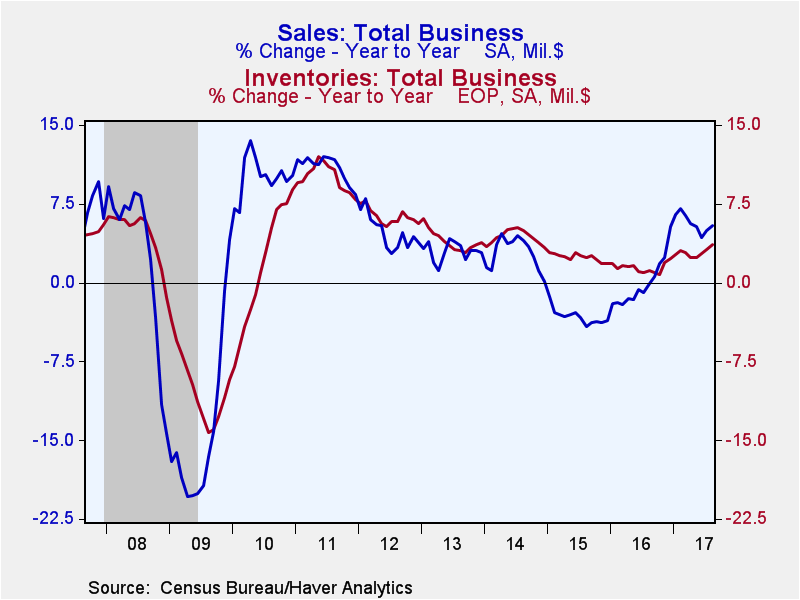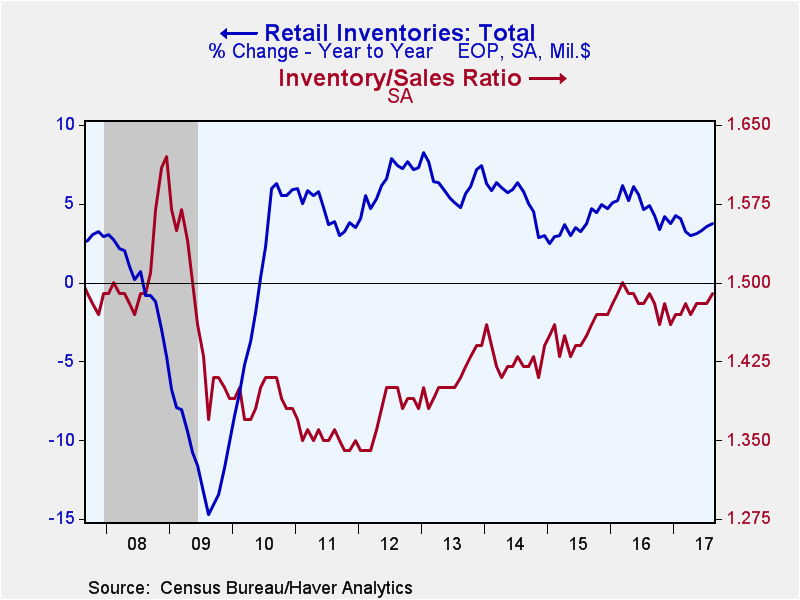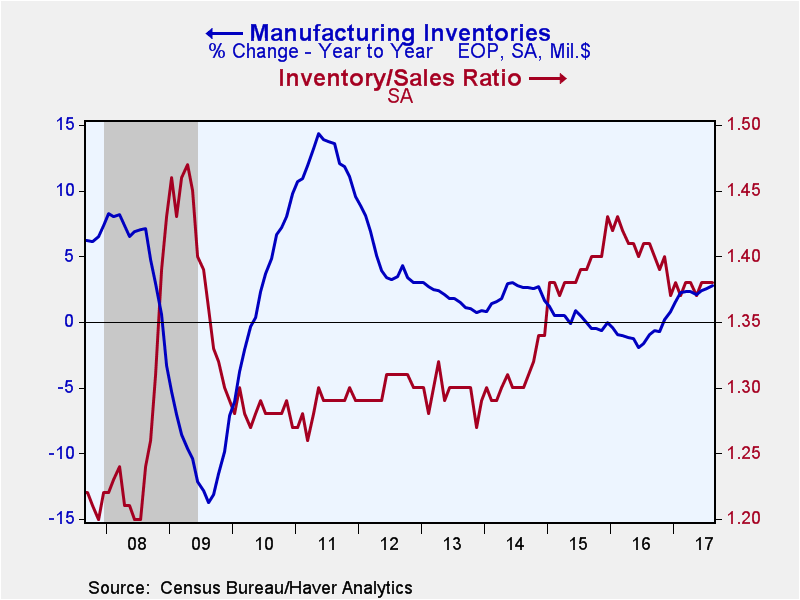 Global| Oct 13 2017
Global| Oct 13 2017U.S. Business Inventories and Sales Both Rise in August
by:Sandy Batten
|in:Economy in Brief
Summary
Total business inventories increased 0.7% m/m (3.6% y/y) in August following an upwardly revised 0.3% m/m rise in July. Retail inventories also rose 0.7% m/m (3.7% y/y) in August after having been unchanged in July. Again, motor [...]
Total business inventories increased 0.7% m/m (3.6% y/y) in August following an upwardly revised 0.3% m/m rise in July. Retail inventories also rose 0.7% m/m (3.7% y/y) in August after having been unchanged in July. Again, motor vehicle and parts inventories played a meaningful role in the overall performance of retail inventories. Motor vehicle and parts inventories jumped up 1.3% m/m (7.6% y/y) in August after having only edged up 0.2% m/m in July. Retail inventories excluding motor vehicles increased 0.4% (1.7% y/y) after having fallen 0.1% m/m in July. A 0.9% m/m increase in inventories at food and beverage stores was a major driver of the rise in ex-motor vehicle inventories. Wholesale inventories continued to rise sharply, up 0.9% m/m (4.5% y/y) on top of 0.6% monthly gains in May, June and July. Manufacturing inventories rose a relatively more modest 0.4% m/m (2.7% y/y), the same monthly advance as in July.
Business sales also increased 0.7% (5.5% y/y) in August after an upwardly revised 0.3% m/m rise in July. This was the strongest monthly performance of total sales thus far in 2017. Retail sales slipped 0.1% m/m (3.7% y/y) in August, drug down by a 2.1% m/m decline in motor vehicle sales. Excluding autos, sales were up a solid 0.5% m/m (4.4% y/y) in August. Wholesale sector sales jumped 1.7% m/m (7.2% y/y) in August, more than compensating for their unchanged reading in July. Factory shipments rose 0.5% m/m (5.3% y/y) in August, up from a downwardly revised 0.2% increase in July.
In general, business sales continue to grow more rapidly than inventories though the gap has shrunk over the past several months. As a result, apart from the overall retail sector, inventory-to-sales ratios are lower now than they were a year ago. The business sector inventory-to-sales ratio was unchanged at 1.38 in August. The retail I/S ratio edged up to 1.49 from 1.48, where it has been for most of this year. The I/S ratio for the retail sector excluding autos was unchanged at 1.24 in August, while the I/S ratio for the auto sector rose even further to 2.34 from 2.26 in July. The I/S ratio at food and beverage stores inched up to 0.80 in August from 0.79--it has been either 0.79 or 0.80 for the past two years. With the jump in wholesale sales, the wholesale sector's I/S ratio slipped to 1.28 from a downwardly revised 1.29 in July, while the manufacturing I/S ratio was unchanged at 1.38. The manufacturing I/S ratio has been very stable throughout all of 2017.
The manufacturing and trade data are in Haver's USECON database.
| Manufacturing & Trade | Aug | Jul | Jun | Aug Y/Y | 2016 | 2015 | 2014 |
|---|---|---|---|---|---|---|---|
| Business Inventories (% chg) | 0.7 | 0.3 | 0.5 | 3.6 | 2.3 | 1.8 | 3.4 |
| Retail | 0.7 | 0.0 | 0.6 | 3.7 | 3.8 | 4.7 | 3.0 |
| Retail excl. Motor Vehicles | 0.4 | -0.1 | 0.5 | 1.7 | 1.8 | 3.8 | 2.6 |
| Merchant Wholesalers | 0.9 | 0.6 | 0.6 | 4.5 | 2.5 | 1.2 | 5.8 |
| Manufacturing | 0.4 | 0.4 | 0.3 | 2.7 | 0.8 | -0.1 | 1.6 |
| Business Sales (% chg) | |||||||
| Total | 0.7 | 0.3 | 0.2 | 5.5 | -0.1 | -3.2 | 2.8 |
| Retail | -0.1 | 0.5 | -0.1 | 3.7 | 2.7 | 1.9 | 4.0 |
| Retail excl. Motor Vehicles | 0.5 | 0.6 | -0.2 | 4.4 | 2.3 | 0.4 | 3.3 |
| Merchant Wholesalers | 1.7 | 0.0 | 0.6 | 7.2 | -0.5 | -4.9 | 3.6 |
| Manufacturing | 0.5 | 0.2 | 0.1 | 5.3 | -2.0 | -5.8 | 1.3 |
| I/S Ratio | |||||||
| Total | 1.38 | 1.38 | 1.38 | 1.40 | 1.40 | 1.38 | 1.31 |
| Retail | 1.49 | 1.48 | 1.48 | 1.49 | 1.48 | 1.45 | 1.43 |
| Retail excl. Motor Vehicles | 1.24 | 1.24 | 1.25 | 1.27 | 1.27 | 1.26 | 1.23 |
| Merchant Wholesalers | 1.28 | 1.29 | 1.29 | 1.32 | 1.33 | 1.32 | 1.21 |
| Manufacturing | 1.38 | 1.38 | 1.38 | 1.41 | 1.41 | 1.39 | 1.31 |
Sandy Batten
AuthorMore in Author Profile »Sandy Batten has more than 30 years of experience analyzing industrial economies and financial markets and a wide range of experience across the financial services sector, government, and academia. Before joining Haver Analytics, Sandy was a Vice President and Senior Economist at Citibank; Senior Credit Market Analyst at CDC Investment Management, Managing Director at Bear Stearns, and Executive Director at JPMorgan. In 2008, Sandy was named the most accurate US forecaster by the National Association for Business Economics. He is a member of the New York Forecasters Club, NABE, and the American Economic Association. Prior to his time in the financial services sector, Sandy was a Research Officer at the Federal Reserve Bank of St. Louis, Senior Staff Economist on the President’s Council of Economic Advisors, Deputy Assistant Secretary for Economic Policy at the US Treasury, and Economist at the International Monetary Fund. Sandy has taught economics at St. Louis University, Denison University, and Muskingun College. He has published numerous peer-reviewed articles in a wide range of academic publications. He has a B.A. in economics from the University of Richmond and a M.A. and Ph.D. in economics from The Ohio State University.










